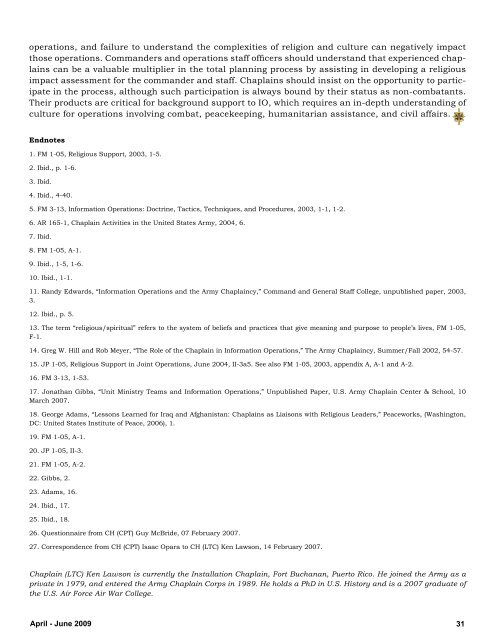Military Intelligence Professional Bulletin - Federation of American ...
Military Intelligence Professional Bulletin - Federation of American ...
Military Intelligence Professional Bulletin - Federation of American ...
Create successful ePaper yourself
Turn your PDF publications into a flip-book with our unique Google optimized e-Paper software.
operations, and failure to understand the complexities <strong>of</strong> religion and culture can negatively impact<br />
those operations. Commanders and operations staff <strong>of</strong>ficers should understand that experienced chaplains<br />
can be a valuable multiplier in the total planning process by assisting in developing a religious<br />
impact assessment for the commander and staff. Chaplains should insist on the opportunity to participate<br />
in the process, although such participation is always bound by their status as non-combatants.<br />
Their products are critical for background support to IO, which requires an in-depth understanding <strong>of</strong><br />
culture for operations involving combat, peacekeeping, humanitarian assistance, and civil affairs.<br />
Endnotes<br />
1. FM 1-05, Religious Support, 2003, 1-5.<br />
2. Ibid., p. 1-6.<br />
3. Ibid.<br />
4. Ibid., 4-40.<br />
5. FM 3-13, Information Operations: Doctrine, Tactics, Techniques, and Procedures, 2003, 1-1, 1-2.<br />
6. AR 165-1, Chaplain Activities in the United States Army, 2004, 6.<br />
7. Ibid.<br />
8. FM 1-05, A-1.<br />
9. Ibid., 1-5, 1-6.<br />
10. Ibid., 1-1.<br />
11. Randy Edwards, “Information Operations and the Army Chaplaincy,” Command and General Staff College, unpublished paper, 2003,<br />
3.<br />
12. Ibid., p. 5.<br />
13. The term “religious/spiritual” refers to the system <strong>of</strong> beliefs and practices that give meaning and purpose to people’s lives, FM 1-05,<br />
F-1.<br />
14. Greg W. Hill and Rob Meyer, “The Role <strong>of</strong> the Chaplain in Information Operations,” The Army Chaplaincy, Summer/Fall 2002, 54-57.<br />
15. JP 1-05, Religious Support in Joint Operations, June 2004, II-3a5. See also FM 1-05, 2003, appendix A, A-1 and A-2.<br />
16. FM 3-13, 1-53.<br />
17. Jonathan Gibbs, “Unit Ministry Teams and Information Operations,” Unpublished Paper, U.S. Army Chaplain Center & School, 10<br />
March 2007.<br />
18. George Adams, “Lessons Learned for Iraq and Afghanistan: Chaplains as Liaisons with Religious Leaders,” Peaceworks, (Washington,<br />
DC: United States Institute <strong>of</strong> Peace, 2006), 1.<br />
19. FM 1-05, A-1.<br />
20. JP 1-05, II-3.<br />
21. FM 1-05, A-2.<br />
22. Gibbs, 2.<br />
23. Adams, 16.<br />
24. Ibid., 17.<br />
25. Ibid., 18.<br />
26. Questionnaire from CH (CPT) Guy McBride, 07 February 2007.<br />
27. Correspondence from CH (CPT) Isaac Opara to CH (LTC) Ken Lawson, 14 February 2007.<br />
Chaplain (LTC) Ken Lawson is currently the Installation Chaplain, Fort Buchanan, Puerto Rico. He joined the Army as a<br />
private in 1979, and entered the Army Chaplain Corps in 1989. He holds a PhD in U.S. History and is a 2007 graduate <strong>of</strong><br />
the U.S. Air Force Air War College.<br />
April - June 2009 31
















